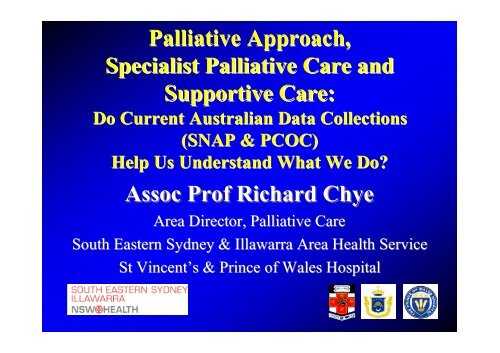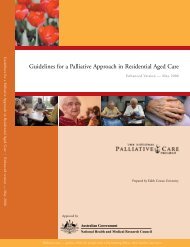Palliative Approach, Specialist Palliative Care and Supportive Care ...
Palliative Approach, Specialist Palliative Care and Supportive Care ...
Palliative Approach, Specialist Palliative Care and Supportive Care ...
You also want an ePaper? Increase the reach of your titles
YUMPU automatically turns print PDFs into web optimized ePapers that Google loves.
<strong>Palliative</strong> <strong>Approach</strong>,<br />
<strong>Specialist</strong> <strong>Palliative</strong> <strong>Care</strong> <strong>and</strong><br />
<strong>Supportive</strong> <strong>Care</strong>:<br />
Do Current Australian Data Collections<br />
(SNAP & PCOC)<br />
Help Us Underst<strong>and</strong> What We Do?<br />
Assoc Prof Richard Chye<br />
Area Director, <strong>Palliative</strong> <strong>Care</strong><br />
South Eastern Sydney & Illawarra Area Health Service<br />
St Vincent’s s & Prince of Wales Hospital
Definitions<br />
<strong>Palliative</strong> <strong>Care</strong> <strong>Approach</strong><br />
A <strong>Palliative</strong> <strong>Approach</strong> is a term that has been<br />
used to describe care that aims to improve the<br />
quality of life for individuals with an<br />
eventually fatal condition, <strong>and</strong> their families,<br />
by reducing their suffering through early<br />
identification, assessment <strong>and</strong> treatment of<br />
pain, physical, psychological, social, cultural<br />
<strong>and</strong> spiritual needs.<br />
Glossary of Terms, <strong>Palliative</strong> <strong>Care</strong> Australia 2008
Definitions<br />
<strong>Palliative</strong> <strong>Care</strong> <strong>Specialist</strong><br />
A <strong>Palliative</strong> <strong>Care</strong> <strong>Specialist</strong> has the<br />
specialist knowledge skills <strong>and</strong> expertise<br />
in care of people living with <strong>and</strong><br />
eventually fatal condition <strong>and</strong> their<br />
families <strong>and</strong> carers, including in the<br />
management of complex symptoms, loss,<br />
grief <strong>and</strong> bereavement.<br />
Glossary of Terms, <strong>Palliative</strong> <strong>Care</strong> Australia 2008
Definitions<br />
<strong>Specialist</strong> <strong>Palliative</strong> <strong>Care</strong> (Provider)<br />
The <strong>Specialist</strong> <strong>Palliative</strong> <strong>Care</strong> Provider is a<br />
Medical, Nursing or Allied Health<br />
professional recognised as a <strong>Palliative</strong><br />
<strong>Care</strong> <strong>Specialist</strong> by an accrediting body or<br />
who substantively works in a <strong>Specialist</strong><br />
<strong>Palliative</strong> <strong>Care</strong> service if an accrediting<br />
body is not available.<br />
Glossary of Terms, <strong>Palliative</strong> <strong>Care</strong> Australia 2008
Definitions<br />
<strong>Specialist</strong> <strong>Palliative</strong> <strong>Care</strong> (Service)<br />
<strong>Specialist</strong> <strong>Palliative</strong> <strong>Care</strong> Services are<br />
provided by an interdisciplinary team of<br />
<strong>Specialist</strong> <strong>Palliative</strong> <strong>Care</strong> professionals<br />
who substantive work is with patients<br />
who have <strong>and</strong> eventually fatal condition.<br />
Glossary of Terms, <strong>Palliative</strong> <strong>Care</strong> Australia 2008
<strong>Supportive</strong> <strong>Care</strong> in Cancer<br />
• is the prevention <strong>and</strong> management of the adverse<br />
effects of cancer <strong>and</strong> its treatment.<br />
• This includes management of physical <strong>and</strong><br />
psychological symptoms <strong>and</strong> side effects across<br />
the continuum of the cancer experience from<br />
diagnosis through anticancer treatment to post-<br />
treatment care.<br />
• Enhancing rehabilitation, secondary cancer<br />
prevention, survivorship <strong>and</strong> end of life care are<br />
integral to <strong>Supportive</strong> <strong>Care</strong>.<br />
Multinational Assoc for <strong>Supportive</strong> <strong>Care</strong> in Cancer
<strong>Supportive</strong> <strong>Care</strong> in Cancer<br />
• alleviates symptoms <strong>and</strong> complications of cancer<br />
• reduces or prevents toxicities of treatment<br />
• supports communication with patients about<br />
their disease <strong>and</strong> prognosis<br />
• allows patients to tolerate <strong>and</strong> benefit from<br />
active therapy more easily<br />
• eases emotional burden of patients <strong>and</strong> care<br />
givers<br />
• helps cancer survivors with psychological <strong>and</strong><br />
social problems
<strong>Supportive</strong> <strong>Care</strong><br />
<strong>Palliative</strong> <strong>Care</strong> now supports patients<br />
undergoing palliative anticancer<br />
treatments<br />
<strong>Palliative</strong> <strong>Care</strong> has developed expertise<br />
looking after problems associated with<br />
cancer treatments
Changing Cancer <strong>Care</strong> Paradigms<br />
<strong>Palliative</strong> <strong>Care</strong> now provides<br />
• <strong>Supportive</strong> <strong>Care</strong><br />
‣Psycho Psycho-Oncology<br />
‣Blood Transfusions<br />
‣Intravenous Antibiotics<br />
‣<strong>Palliative</strong> Chemotherapy<br />
‣<strong>Palliative</strong> Radiotherapy
What is a <strong>Supportive</strong> <strong>Care</strong> Patient?<br />
A Study at Sacred Heart<br />
• From October 2008 to June 2009<br />
• Staff <strong>Specialist</strong>s were asked which category<br />
their patients fulfilled when their patient<br />
was admitted to Sacred Heart.<br />
• three categories<br />
–<strong>Palliative</strong> <strong>Approach</strong><br />
–<strong>Specialist</strong> <strong>Palliative</strong> <strong>Care</strong><br />
–<strong>Supportive</strong> <strong>Care</strong><br />
SVH HREC Approved Study 2009
“<strong>Palliative</strong> <strong>Approach</strong>” as a patient whose<br />
needs could be met by a non specialist<br />
palliative care team “eg. aged care specialist<br />
or general practitioner <strong>and</strong> a generalist<br />
community nurse or non palliative care ward<br />
nurse”.
“<strong>Specialist</strong> <strong>Palliative</strong> <strong>Care</strong>” as patients who<br />
are considered to have complex needs<br />
requiring an interdisciplinary approach from<br />
health professionals who have had specific<br />
palliative care training or a specialist in<br />
their field of palliative care. These patients are<br />
more likely to have problems associated<br />
with their disease.
“<strong>Supportive</strong> <strong>Care</strong>” as patients who require<br />
care whilst they undergo active anti-cancer<br />
treatment, be it of palliative or curative<br />
intent. These patients are more likely to<br />
develop or have problems associated with<br />
their treatment.
Sub Acute, Non Acute Program<br />
(SNAP)<br />
• Developed in 1980s-90s<br />
90s<br />
• To describe (<strong>and</strong> fund) subacute services<br />
like palliative care where Diagnostic<br />
Related Groups (DRGs) are inappropriate
Sub Acute, Non Acute Program<br />
Uses<br />
• Age<br />
• Phase<br />
(SNAP)<br />
Stable, Unstable, Deteriorating, Terminal<br />
• Symptom Severity Scores<br />
• RUG-ADL Scores<br />
Pain, Other Symptom, Psychosocial, Family<br />
Bed Mobility, Toileting, Transfer Eating
<strong>Palliative</strong> <strong>Care</strong> Outcomes<br />
Collaboration (PCOC)<br />
Headed by the University of Wollongong<br />
Uses SNAP plus<br />
• Karnofsky<br />
• <strong>Palliative</strong> <strong>Care</strong> Symptom Assessment Score<br />
Insomnia, Appetite, Nausea, Bowels,<br />
Breathing, fatigue, Pain
Experience at Sacred Heart<br />
• 538 admissions involving 456 patients<br />
• 56 patients (accounting for 82 admissions) were<br />
admitted more than once <strong>and</strong> up to 5 instances.<br />
• The large majority of admissions (74%) were<br />
documented as ‘<strong>Specialist</strong> <strong>Palliative</strong> <strong>Care</strong>’.
Experience at Sacred Heart<br />
• The large majority of admissions (74%(<br />
74%) ) were<br />
documented as ‘<strong>Specialist</strong> <strong>Palliative</strong> <strong>Care</strong>’<br />
• 15% were documented as ‘<strong>Palliative</strong> <strong>Approach</strong>’<br />
• 11% were documented as ‘<strong>Supportive</strong> <strong>Care</strong>’
Experience at Sacred Heart<br />
Male<br />
Female<br />
<strong>Palliative</strong><br />
<strong>Approach</strong><br />
<strong>Specialist</strong><br />
<strong>Palliative</strong> <strong>Care</strong><br />
48% 52%<br />
52% 48%<br />
<strong>Supportive</strong> <strong>Care</strong> 84% 16%<br />
Chi-Square Test: Significant difference between the 3 groups P< 0.001
Experience at Sacred Heart<br />
Mean Age<br />
Range<br />
<strong>Palliative</strong> <strong>Approach</strong> 77.3 41 to 100<br />
<strong>Specialist</strong> <strong>Palliative</strong><br />
<strong>Care</strong><br />
69.7 30 to 97<br />
<strong>Supportive</strong> <strong>Care</strong> 61.8 30 to 90<br />
One-Way ANOVA: Significant P
Experience at Sacred Heart<br />
LOS<br />
Range<br />
<strong>Palliative</strong> <strong>Approach</strong> 17.8 0 to 205<br />
<strong>Specialist</strong> <strong>Palliative</strong><br />
<strong>Care</strong><br />
17.0 0 to 196<br />
<strong>Supportive</strong> <strong>Care</strong> 17.3 1 to 101<br />
One-Way ANOVA: No Significant Difference (p>0.05)
Experience at Sacred Heart<br />
Diagnosis<br />
<strong>Palliative</strong><br />
<strong>Approach</strong><br />
<strong>Specialist</strong><br />
<strong>Palliative</strong> <strong>Care</strong><br />
<strong>Supportive</strong><br />
<strong>Care</strong><br />
Cancer<br />
50<br />
(62%)<br />
344<br />
(86%)<br />
39<br />
(67%)<br />
HIV<br />
0<br />
(0%)<br />
6<br />
(2%)<br />
12<br />
(21%)<br />
Other Non<br />
Cancer<br />
31<br />
(38%)<br />
49<br />
(12%)<br />
7<br />
(12%)<br />
Chi Square Test: Significant difference P< 0.001<br />
between proportions of cancer, AIDS <strong>and</strong> other diseases
Experience at Sacred Heart<br />
Phase Stable Unstable Deteriorating Terminal<br />
<strong>Palliative</strong><br />
<strong>Approach</strong><br />
36<br />
(44%)<br />
6<br />
(7%)<br />
16<br />
(20%)<br />
23<br />
(28%)<br />
<strong>Specialist</strong><br />
<strong>Palliative</strong><br />
<strong>Care</strong><br />
105<br />
(26%)<br />
74<br />
(19%)<br />
103<br />
(26%)<br />
115<br />
(29%)<br />
<strong>Supportive</strong><br />
<strong>Care</strong><br />
46<br />
(79%)<br />
10<br />
(17%)<br />
2<br />
(3%)<br />
0<br />
(0%)<br />
Chi-Square Test: Significant difference P< 0.001<br />
between the 3 treatment groups in phase class proportions.
Experience at Sacred Heart<br />
Discharge<br />
Destination<br />
“Home”<br />
Transfer<br />
Hospital<br />
Death<br />
<strong>Palliative</strong><br />
<strong>Approach</strong><br />
35<br />
(43%)<br />
0<br />
(0%)<br />
44<br />
(54%)<br />
<strong>Specialist</strong><br />
<strong>Palliative</strong> <strong>Care</strong><br />
107<br />
(27%)<br />
21<br />
(5%)<br />
262<br />
(66%)<br />
<strong>Supportive</strong><br />
<strong>Care</strong><br />
42<br />
(72%)<br />
9<br />
(16%)<br />
2<br />
(3%)<br />
Chi Square Test: Significant difference P< 0.001, across the 3 treatment groups
Experience at Sacred Heart<br />
Dependence<br />
RUG-ADL<br />
Median<br />
Inter Quartile<br />
Range<br />
<strong>Palliative</strong> <strong>Approach</strong> 18 9-18<br />
<strong>Specialist</strong> <strong>Palliative</strong><br />
<strong>Care</strong><br />
16 10-18<br />
<strong>Supportive</strong> <strong>Care</strong> 4 4-11<br />
Kruskal Wallis Test: Significant difference (P< 0.001) between the 3 treatment groups
Experience at Sacred Heart<br />
Karnofsky Scores<br />
Median<br />
Inter Quartile<br />
Range<br />
<strong>Palliative</strong> <strong>Approach</strong> 20 20-60<br />
<strong>Specialist</strong> <strong>Palliative</strong> <strong>Care</strong> 30 20-50<br />
<strong>Supportive</strong> <strong>Care</strong> 60 50-80<br />
Kruskal Wallis Test: Significant difference P< 0.001
Experience at Sacred Heart<br />
Problem<br />
Severity Scores<br />
Median<br />
Inter Quartile<br />
Range<br />
<strong>Palliative</strong> <strong>Approach</strong> 6 4-9<br />
<strong>Specialist</strong> <strong>Palliative</strong><br />
<strong>Care</strong><br />
7.5 6-9<br />
<strong>Supportive</strong> <strong>Care</strong> 6 5-8<br />
Kruskal Wallis Test: Significant difference (P< 0.001) between the 3 treatment groups
Experience at Sacred Heart<br />
Symptom<br />
Assessment Scale<br />
Median<br />
Inter Quartile Range<br />
<strong>Palliative</strong> <strong>Approach</strong> 16 10.5-26.5<br />
<strong>Specialist</strong> <strong>Palliative</strong><br />
<strong>Care</strong><br />
24 16-34<br />
<strong>Supportive</strong> <strong>Care</strong> 20 11-25<br />
Kruskal Wallis Test: Significant difference (P< 0.001) between the 3 treatment groups
Conclusions<br />
There was some difference between “a<br />
<strong>Palliative</strong> <strong>Approach</strong>” & “<strong>Specialist</strong><br />
<strong>Palliative</strong> <strong>Care</strong>” in terms of<br />
Cancer Diagnoses (<strong>Specialist</strong>)<br />
Younger Age (<strong>Specialist</strong>)<br />
More Symptoms (<strong>Specialist</strong>)<br />
More Dependency (Pall <strong>Approach</strong>)
Conclusions<br />
There was little difference between “a<br />
<strong>Palliative</strong> <strong>Approach</strong>” & “<strong>Specialist</strong><br />
<strong>Palliative</strong> <strong>Care</strong>” in terms of<br />
Sex<br />
Length of Stay<br />
Discharge Destination<br />
Phase
What is a <strong>Supportive</strong> <strong>Care</strong> Patient?<br />
• Male<br />
• Younger<br />
• More independent<br />
• Many have cancer<br />
• HIV patients classified more as supportive<br />
care now, as it is more of a chronic illness<br />
than a terminal illness<br />
• More likely to be discharged home
Acknowledgements<br />
Medical <strong>Specialist</strong><br />
Neil Cooney, Philip Macaulay<br />
Phillip Redelman, Jane Ingham<br />
Data Manager<br />
David Webb<br />
Statistical Support<br />
Michael Piza

















